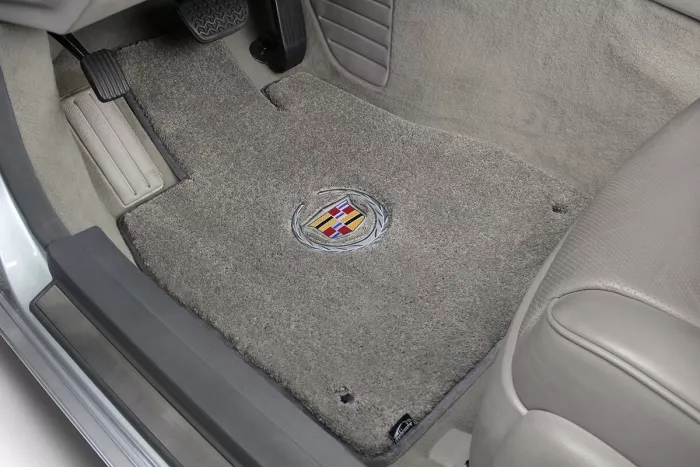On any given day, your car could be stained with dirt, snow, mud, or maybe even a gift that your dog left behind. Even the most diligent owners can’t avoid tracking in dirt.
If you were ever forced to clean stains from your original carpet, you probably wished you had floor mats.
A car mat is much easier to clean than a factory carpet. It’s also way cheaper to replace it than redoing the flooring.
So, as a classic car owner, you should choose floor mats that’ll protect your car’s interior.
In this guide, we’ll go over everything you need to know about selecting and maintaining the ideal set of floor mats for your vintage ride.
How to Choose the Ideal Floor Mats for Your Classic Car
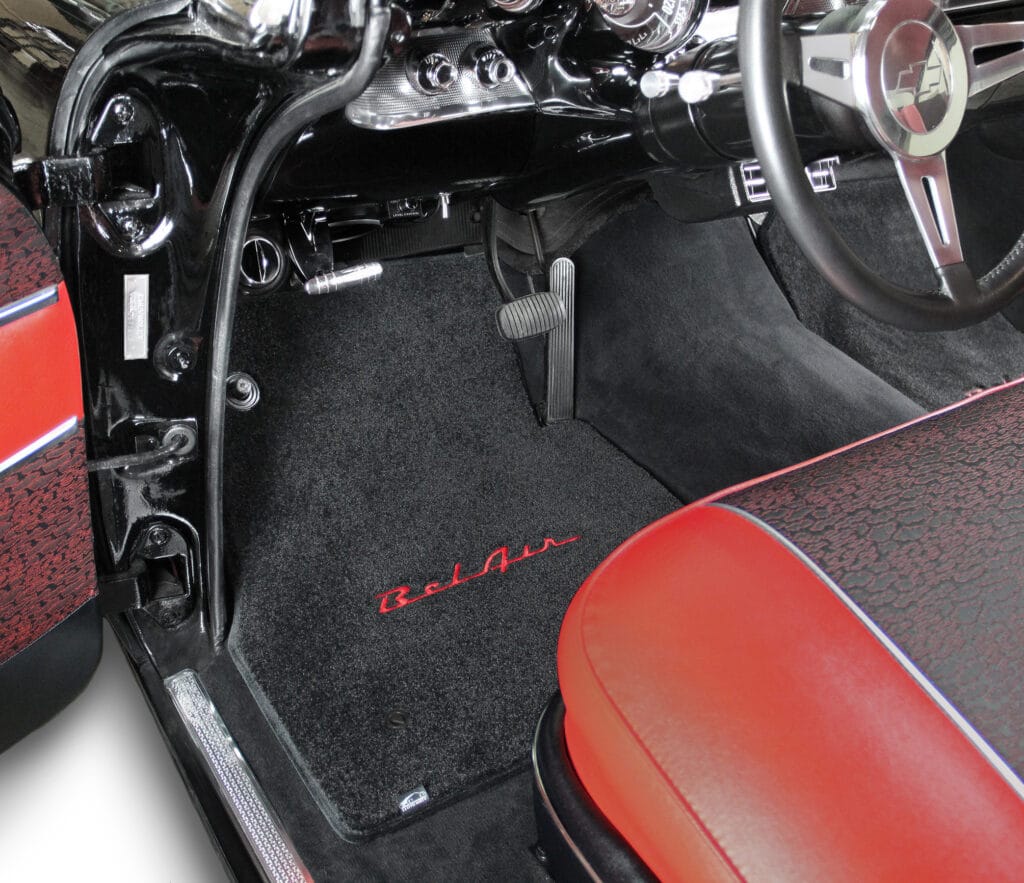
When you own a classic ride, you can’t just pick any set of car mats. To make your floor look and feel authentic, ensure the carpets perfectly match your vehicle’s year, make, and model.
For example, a 1960 Plymouth Valiant 100 will require different car mats than a 1972 AMC Hornet. The floor mats for a 1975 Pontiac Firebird will also not fit a 1968 Chevrolet Camaro. When it comes to car floor mats, one size does not fit all.
What Type of Car Mats Should You Select?
Depending on your need, you can buy car mats individually, in sets of two (front or back) or groups of four (front and rear).
Floor mats come in three fit types:
- universal fit
- trim-to-fit
- custom fit
You can use universal fit mats in almost any car because they aren’t made for any specific vehicle. They’re usually mass-produced, so they’re much cheaper.
Trim-to-fit mats (as the name implies) have extra rubber around the edges that can be trimmed to precisely fit the car’s floor.
Custom-fit mats are made to fit your interior perfectly. To get the exact product, you’ll need to select your vehicle brand on partcatalog.com. For classic or vintage cars, our recommendation is the Lloyd Ultimat.
These mats offer the most protection because they’re made using accurate measurements of your ride’s year, make, and model.
We recommend going for the custom-fit types, because if you buy a mat that isn’t a perfect fit for your car’s floor plan, you risk getting insufficient coverage. You might also get a big carpet that gets in the way of your feet while trying to hit the gas or brake.
Fortunately, PartCatalog has a variety of brands to choose from. Here’s a summary of the available Lloyd carpet floor mats.
| Luxe | Ultimat | Velourtex | Berber | Classic Loop | |
| Price | |||||
| Carpet type | Cut Pile (Very plush) | Cut Pile (Normal) | Cut Pile (Economical) | Berber (Industrial-Like) | Looped (Industrial-Like) |
| #colors | 11 | 50 | 10 | 9 | 9 |
| Logos | Yes | Yes | Yes | Yes | Yes |
| Warranty | Lifetime | 5 years | 3 years | 5 years | 2 years |
The Lloyd mats have TractionBac Rubber backing to keep them firmly in place without damaging the car’s carpet.
Here’s what a customer said about these mats:
“Very good workmanship. The stitching is tight and doesn’t look like cheap work. These mats should last as long as the car.”
— Thomas T.
What Car Mat Material Should You Choose?
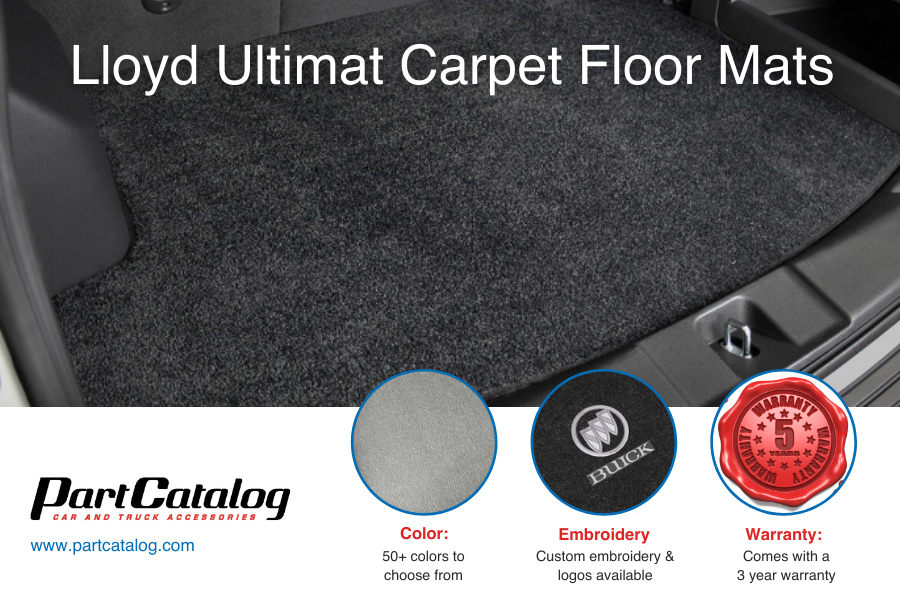
Choosing between rubber and carpet floor mats is like making any other decision in life. Yes, they’re just car mats, but you deserve to be satisfied with them, given how much time you spend in your car.
To help you make a better choice depending on your needs, taste, and lifestyle, here are the pros and cons of both.
Rubber Floor Mats
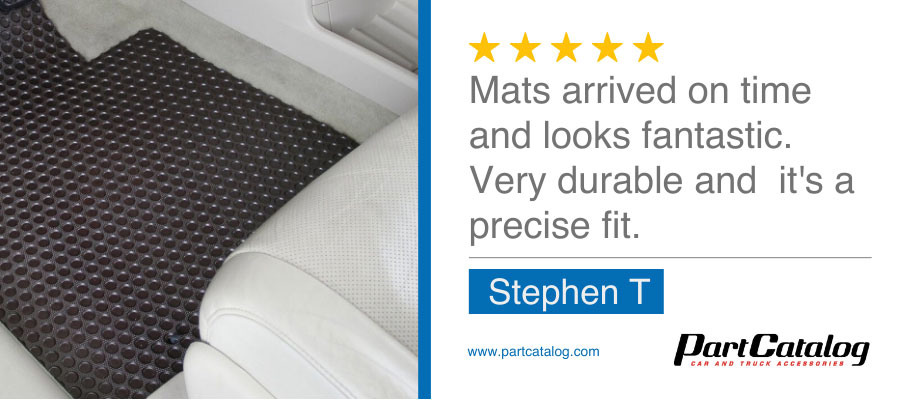
Pros:
- They’re easy to clean
- Rubber mats are more economical than carpet floor mats.
- They provide better protection than their carpet counterparts.
- These mats are more durable and designed to withstand harsh climates.
Cons:
- Rubber mats are not as aesthetically pleasing as carpet mats.
- They have limited colors—they come in black, grey, and sometimes tan.
Carpet Floor Mats
Pros:
- They are suitable for life in the city or areas where you don’t encounter lots of sand, snow, mud, or loose dirt.
- They come in a vast array of colors.
- These mats come with logos and can be embroidered with initials or names. They can also be woven with multicolor fibers to fit your personal taste.
- The mats have a wide choice of carpet fibers—from Classic Loop to Berber and other plush luxury versions
Cons:
- They stain more easily.
- They aren’t as resistant to wear and tear as rubber.
After evaluating the pros and cons, here’s what we recommend.
Choose rubber floor mats if:
- You usually eat or drink in the car. Rubber floor mats can withstand the abuse of hard day-to-day living better than their carpet counterparts.
- You live in extreme weather environments that have snow or mud.
- You travel a lot with your pets.
We recommend carpet floor mats if:
- You want an exact color or design match between your interior and floor carpet—classic or sports car enthusiasts love this option.
- You want to have custom colors or binding for your car mats.
- You prefer a better look and feel for the interior of your vehicle.
How to Clean Your Floor Mats
When was the last time you cleaned your car mats? Unfortunately, many car owners overlook the floor mats for way too long—leaving mud, stains, and sticky substances unchecked.
On a hot day, dirty car carpets can start to stink. Cleaning them, though, isn’t as hard as one may think. The best part is that you don’t have to do deep cleaning regularly as long as you clean spills immediately.
That said, here’s how to clean your car mats:
Step 1: Remove the Loose Dirt
Take the mats out of your vehicle and vacuum them well. This step is essential because it removes any loose dirt from the floor mats.
Step 2: Hose the Car Mats
Take your water hose and spray the mats once you clear all loose dirt. Then, pat the carpets in the air to drain any excess water.
Step 3: Clean the Mats Using Detergent
Spray the floor mats with your favorite mild detergent. Allow them to soak for a few minutes to help loosen the tough stains.
Step 4: Scrub the Floor Mats
Scrub the mats with a bristle brush, paying particular attention to the ridges. Although the initial wash typically removes all dirt, you can scrub them a couple more times if you notice tough spots.
Step 5: Rinse the Mats
Rinse the floor mats thoroughly with your water hose.
Step 6: Dry the Car Mats
Allow the mats to dry in the open. You can also use a heat dryer.
Maintaining the Floor Mats
Finally, no matter how well you clean your mats, they’ll get dirty again at some point.
While you can’t prevent this from happening, you can prolong the time till your next wash.
Here are a few pointers to save you the effort of cleaning your floor mats more than once a month:
- Keep your shoes clean when entering your ride.
- If you’re going to a sandy place, such as the beach, keep the doors shut at all times.
- Don’t take off your shoes in the car because sweat from your feet can seep into the carpet and leave a bad smell.

FAQs About Car Mats
Do I Need Car Mats?
Yes, you do.
Car mats protect your vehicle from stains and wear. As mentioned earlier, replacing a floor mat is much easier than redoing the carpet.
Made-to-fit mats will raise the value of your ride. If you want to sell your vintage car, the condition of the upholstery and carpet can affect its price, so always go for custom-fit mats.
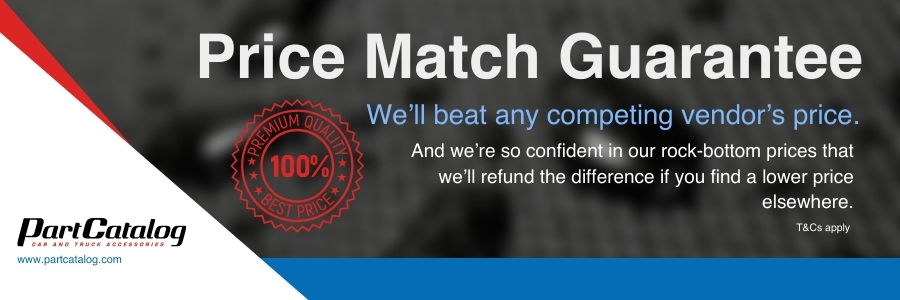
Fitting floor mats can also give you improved footing while driving, making it safer and more fun.
Do Floor Mats Fit All Cars?
Manufacturers design all universal-fit floor mats to be used in all rides. This means that no vehicle will have a perfect fit, but the mats should cover most areas.
However, there are custom-fit mats designed to fit your specific car’s interior. These are the best because they offer your vehicle maximum protection.
Are Rubber Car Mats Toxic?
Designers make some rubber mats with a chemical called BPA or bisphenol-A.
Although the FDA has stated that small amounts of these substances are safe, the mats have a strong chemical smell.
If you’re sensitive to these odors, we recommend that you buy mat sets that say “non-toxic,” “odorless,” or “BPA-free.”

